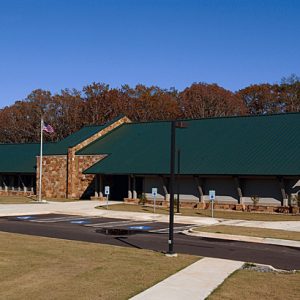calsfoundation@cals.org
Dale Bumpers White River National Wildlife Refuge
aka: White River National Wildlife Refuge
The Dale Bumpers White River National Wildlife Refuge, located in the floodplain of the White River near its confluence with the Mississippi River, was established in 1935 as the White River National Wildlife Refuge. Its purpose is to provide protection for birds traveling on the Mississippi Flyway during the migration seasons. The refuge also serves to protect the wildlife living there and to preserve the area’s natural beauty.
The National Wildlife Refuge program began in 1903 to preserve nesting sites in remote areas such as south Florida and Alaska. In the 1930s, it was expanded to include sites along migratory routes of North America’s waterfowl. The White River National Wildlife Refuge was the second such refuge established in Arkansas. Like others of its kind, it was acquired by the federal government through funds raised by the Duck Stamp, a tax paid by hunters.
The refuge stretches for about ninety miles along the lower White River, and its topography is varied. It boasts 356 natural and manmade lakes consisting of 4,000 acres of water. Among its most unique and important features are the southern bottomland hardwood forests. Roughly 154,000 acres of the refuge are forested, 900 acres are planted with crops, and 1,000 acres are grasslands. The natural terrain attracts many different kinds of birds, including migratory songbirds. Starting in the fall months and proceeding through the peak time in late December, birds continue to arrive, and up to 350,000 birds may spend the winter here.
The refuge is home to about two-thirds of all the bird species found in Arkansas, many of which are “part-time residents.” Some of these include varieties of ducks, geese, and swans, as well as American Pelicans, loons, cormorants, wading birds, hawks, shorebirds, gulls and terns, doves, cuckoos, owls, nighthawks, hummingbirds, woodpeckers, warblers, buntings, finches, and more.
Another important goal of the National Wildlife Refuge is to protect endangered species living in the area and to preserve the natural diversity of life there. While much of the Delta was claimed for agricultural purposes during the nineteenth century, other parts of the Delta remained largely unsettled until late in the century, when the population began to increase along the river. With the increase in human numbers came an accompanying decrease in natural resources and wildlife due to industry and hunting. With the establishment of the refuge, however, species and vegetation began to thrive once again. There are native black bears and reports of at least four active bald eagle nests. For the eagles’ protection, the U.S. Fish and Wildlife Service regulates hunting on the refuge.
Wildlife hunted during various seasons in the refuge includes waterfowl, turkeys, squirrels, rabbits, and deer. Fishing and frogging are also allowed at certain sites and at certain times. The refuge offers camping sites, hiking trails, and many boating areas. In 2003, a 10,000-square-foot visitor center was opened.
In April 2014, the refuge was renamed the Dale Bumpers White River National Wildlife Refuge to honor former Arkansas governor and senator Dale Bumpers.
The refuge receives about 520,000 visitors (in-state and out-of-state) per year. Fourteen staff members maintain the property and resources of the refuge and lead educational programs for visitors. The refuge’s visitor center is located in St. Charles (Arkansas County).
For additional information:
Butcher, Russell D. America’s National Wildlife Refuges: A Complete Guide. Lanham, MD: Roberts Rinehart Publishers, 2003.
Dale Bumpers White River National Wildlife Refuge. http://www.fws.gov/whiteriver/ (accessed April 18, 2022).
Grove, Noel. Wild Lands for Wildlife: America’s National Refuges. Washington DC: National Geographic Society, 1984.
Robinson, Bob. “A Bumper Trip.” Arkansas Democrat-Gazette, November 19, 2018, pp. 1D, 6D. Online at https://www.arkansasonline.com/news/2018/nov/19/a-bumper-trip-20181119/ (accessed June 25, 2024).
White, Mel. “Heartlands and Hardwoods: The White River Bottomland Controversy.” Arkansas Times, October 1981, pp. 100–107.
Sharon Yarbrough
Searcy, Arkansas
Staff of the CALS Encyclopedia of Arkansas



 Cannon at White River National Wildlife Refuge
Cannon at White River National Wildlife Refuge  White River Boardwalk Trail
White River Boardwalk Trail  WRNWR Visitors Center
WRNWR Visitors Center 



Comments
No comments on this entry yet.